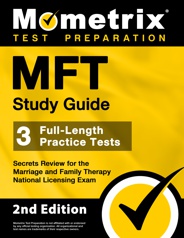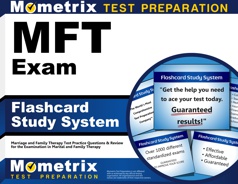The Marital and Family Therapy (MFT) exam is administered by the Association of Marital and Family Therapy Regulatory Boards for those wishing to become licensed as a marital and family therapist.
Click “Start Test” above to take a free MFT practice test!
MFT Exam Eligibility
The eligibility requirements you must meet are established by the state board of jurisdiction where you will practice. Before you can register to take the MFT exam, you must contact your state board and find out what requirements they have.
MFT Exam Outline
The MFT exam contains 180 multiple-choice questions and has a time limit of 4 hours.
The exam is split into six domains of practice.
1. The Practice of Systemic Therapy (42 questions)
The questions in this domain relate to the incorporation of systemic theory and perspectives into practice activities, as well as creating ongoing therapeutic relationships with the client system.
2. Assessing, Hypothesizing, and Diagnosing (25 questions)
The questions in this domain relate to the formation of hypotheses, guidance of therapeutic activities, and assessment of the various dimensions of the client system.
3. Designing and Conducting Treatment (22 questions)
The questions in this domain relate to the development and implementation of client system interventions.
4. Evaluating Ongoing Process and Terminating Treatment (31 questions)
The questions in this domain relate to the incorporation of feedback into the course of treatment, as well as the planning process for termination.
5. Managing Crisis Situations (26 questions)
The questions in this domain relate to the management of emergency situations, as well as intervention when legally mandated or clinically indicated.
6. Maintaining Ethical, Legal, and Professional Standards (34 questions)
The questions in this domain relate to the maintenance of competency in the field, the ongoing adherence to ethical and legal codes, and overall professionalism.
Check out Mometrix's MFT Study Guide
Get practice questions, video tutorials, and detailed study lessons
Get Your Study Guide
MFT Exam Registration
To register for the exam, your state jurisdiction must approve your eligibility. Once they finalize your eligibility, you will be given a letter of approval, which contains a code that you will need to provide during the application process.
To apply, visit the Professional Testing Corporation website and fill out an application and pay the $365 examination fee. Once your application is approved, you will be provided with your candidate ID and scheduling information. You will then need to schedule your exam with Prometric.
Test Day
On the day of your exam, you should arrive at the testing center at least 30 minutes before the scheduled start time. Once you arrive, you will be asked to present two forms of valid identification, one of which must contain your photo.
Once your ID is checked, your picture will be taken, a digital image of your fingerprint will be taken, and you will be asked to undergo a met. You will then be asked to put any personal items in a locker outside the testing room.
You will be asked to stop testing and leave the room immediately if you violate any security regulations, and no scores will be given for your test.
How the MFT Exam is Scored
Your MFT score is based on the modified-Angoff method and is solely determined based on your performance on the examination, with no prior work experience or variables factored into your score. A passing score is determined by subject matter experts, who evaluate questions on the NCE exam to establish a number of correct responses that would adequately demonstrate the required level of proficiency.
Check out Mometrix's MFT Flashcards
Get complex subjects broken down into easily understandable concepts
Get Your Flashcards
How to Pass the MFT Exam
How to Study Effectively
Your success on MFT test day depends not only on how many hours you put into preparing but also on whether you prepared the right way. It’s good to check along the way to see whether your studying is paying off. One of the most effective ways to do this is by taking MFT practice tests to evaluate your progress. Practice tests are useful because they show exactly where you need to improve. Every time you take a free MFT exam practice test, pay special attention to these three groups of questions:
- The questions you got wrong
- The ones you had to guess on, even if you guessed right
- The ones you found difficult or slow to work through
This will show you exactly what your weak areas are and where you need to devote more study time. Ask yourself why each of these questions gave you trouble. Was it because you didn’t understand the material? Was it because you didn’t remember the vocabulary? Do you need more repetitions on this type of question to build speed and confidence? Dig into those questions and figure out how you can strengthen your weak areas as you go back to review the material.
Answer Explanations
Additionally, many MFT practice tests have a section explaining the answer choices. It can be tempting to read the explanation and think that you now have a good understanding of the concept. However, an explanation likely only covers part of the question’s broader context. Even if the explanation makes sense, go back and investigate every concept related to the question until you’re positive you have a thorough understanding.
Comprehend Each Topic
As you go along, keep in mind that the MFT practice test is just that: practice. Memorizing these questions and answers will not be very helpful on the actual test because it is unlikely to have any of the same exact questions. If you only know the right answers to the sample questions, you won’t be prepared for the real thing. Study the concepts until you understand them fully, and then you’ll be able to answer any question that shows up on the test.
Strategy for MFT Practice
When you’re ready to start taking practice tests, follow this strategy:
- Remove Limitations. Take the first test with no time constraints and with your notes and MFT study guide handy. Take your time and focus on applying the strategies you’ve learned.
- Time Yourself. Take the second practice test “open book” as well, but set a timer and practice pacing yourself to finish in time.
- Simulate Test Day. Take any other practice tests as if it were test day. Set a timer and put away your study materials. Sit at a table or desk in a quiet room, imagine yourself at the testing center, and answer questions as quickly and accurately as possible.
- Keep Practicing. Keep taking practice tests on a regular basis until you run out of practice tests or it’s time for the actual test. Your mind will be ready for the schedule and stress of test day, and you’ll be able to focus on recalling the material you’ve learned.
FAQs
Q
How long is the MFT exam?
A
The time limit for the exam is 4 hours.
Q
How many questions are on the MFT exam?
A
There are 180 multiple-choice questions on the exam.
Q
What is the passing score on the MFT exam?
A
Because the questions on various administrations of the exam vary in difficulty, there is no single number that constitutes a passing score for this exam.
Q
How much does the MFT exam cost?
A
The examination fee is $365.

